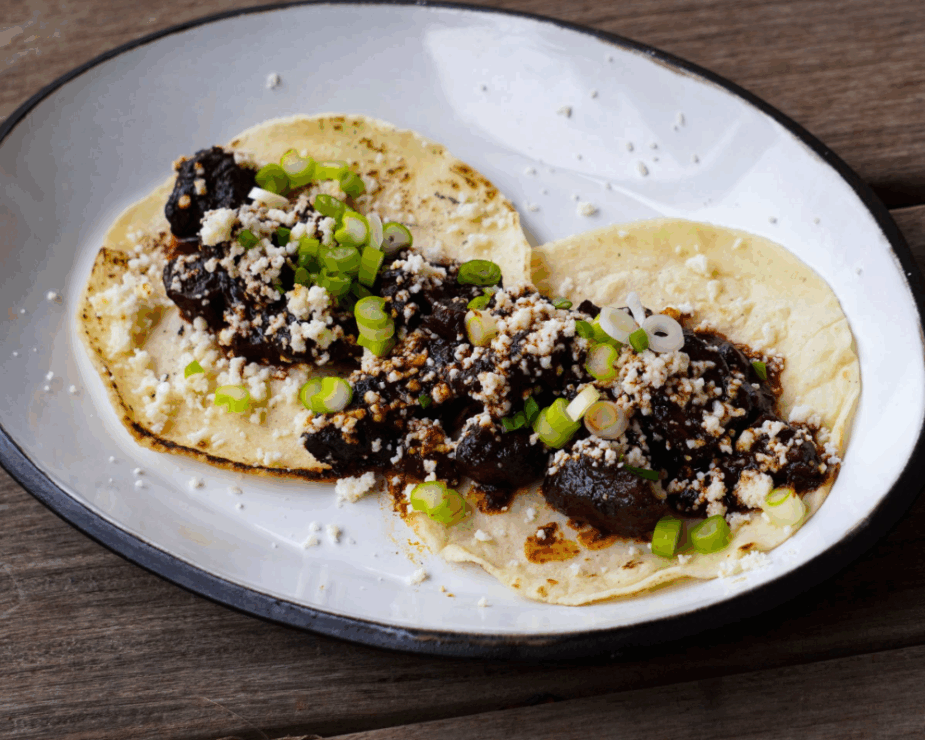
If I were asked to choose a single flavor that’s emblematic of central Mexican cooking, I could easily make a case for pasilla chile. Its unique flavor–earthy and chocolatey with echoes of dark, dried fruits–is partly due to the fact that as the chile matures on the plant, it doesn’t lose its green chlorophyll as it develops reddish beta carotene. Instead of bright red pasilla chiles hanging on plants in the fall, they are the color of a Hershey’s bar–a hue you get when mixing green and red. Taste-wise, the green flavors dry to ones reminiscent of tobacco and straw, while the cranberry-red shows up as spicy dried plums and chocolate. Pasilla chile is uniquely addictive, by most people’s accounts, which is why you find this pork-pasilla stew in so many tacos de guisados places. Given the richness of flavor offered by the pasillas, the fresh flavor of queso fresco is a welcome garnish, as can be onion and cilantro if those appeal.
If you’re not using a high-speed blender, you can eliminate any chances of grittiness in the sauce by passing it through a medium-mesh strainer.
INGREDIENTS
- 1/2 cup fresh-rendered pork lard, bacon drippings or vegetable oil, plus more if needed
- 4 garlic cloves, peeled
- 8 large (3 ounces) dried pasilla chiles, (aka pasilla negro) stemmed, seeded and torn into flat pieces
- 2 pounds boneless pork shoulder roast, cut into pieces a little smaller than 1 inch
- Salt
- About 1 1/2 teaspoons dried oregano, preferably Mexican
- 1/2 teaspoon black pepper
- 1/4 teaspoon ground cumin (preferably fresh ground)
- 4 cups (about 8 ounces) chopped mushrooms (½-inch pieces), anything from cremini and oyster to shiitake
- Sugar, optional
- About 1 cup crumbled Mexican queso fresco or other fresh cheese such as feta or goat cheese
- About a cup of finely chopped white onion and cilantro, if you wish
- 16 warm corn tortillas
INSTRUCTIONS
Toast the chiles, brown the meat. In a large (4-quart) saucepan or small Dutch oven, heat the lard, drippings or oil over medium. When hot, add the garlic and cook, stirring regularly until the cloves are golden. With a slotted spoon, scoop into a blender jar. Return the pan to the heat and, when hot, fry the chile pieces a small handful at a time, turning them nearly constantly with tongs or a slotted spoon as they toast and release their aroma. (It’ll only take a few seconds. They’ll lighten in color a little on the flesh side. Too much toasting will give the sauce a bitter edge.) Immediately remove to a bowl, leaving behind as much fat as possible. When all are fried, cover with hot tap water, weight with a plate and rehydrate for 30 minutes.
Meanwhile, sprinkle the meat generously with salt and toss to coat evenly. Return the pan to medium-high heat and, if necessary, add more fat to coat the bottom of the pan. In uncrowded batches, brown the meat on all sides, transferring each batch to a rimmed baking sheet when ready.
Finish the sauce, braise the meat. Drain the chile-soaking liquid into a measuring cup. Taste: if the liquid is bitter, discard it. Scoop the soaked chiles into the blender jar and add 1¼ cup of soaking liquid or water. Add the oregano, pepper and cumin. Blend to a smooth puree, adding a bit more water if needed to keep the mixture moving through the blender.
Return the pan to medium-high heat and add more fat, if necessary, to coat the bottom of the pan. When hot, add the chile puree and stir continually until it has thickened to the consistency of tomato paste, 3 to 5 minutes. Return the meat to the pan, add the mushrooms and 1 ½ cups water, bring to a boil, reduce the heat to medium-low, partially cover and simmer until the meat is fork tender, about 1 hour. If the consistency is light and runny, simmer over medium to medium-high heat, stirring frequently, until the mixture easily holds is shape in a spoon–otherwise it will run out of the tacos you’re going to make. Taste and season with salt, usually about 1 ½ teaspoons and sugar, usually about 1 teaspoon.
Serve. Scoop the mixture into a serving bowl and set out with the queso fresco, onions and cilantro (if you’ve chosen to offer them) and warm tortillas for everyone to make tacos.
Variations I enjoy. Replacing the pork with lamb is a favorite, as is using chayote instead of mushrooms. I like to roast the chayote with a little oil and salt, then stir it in just before serving.




